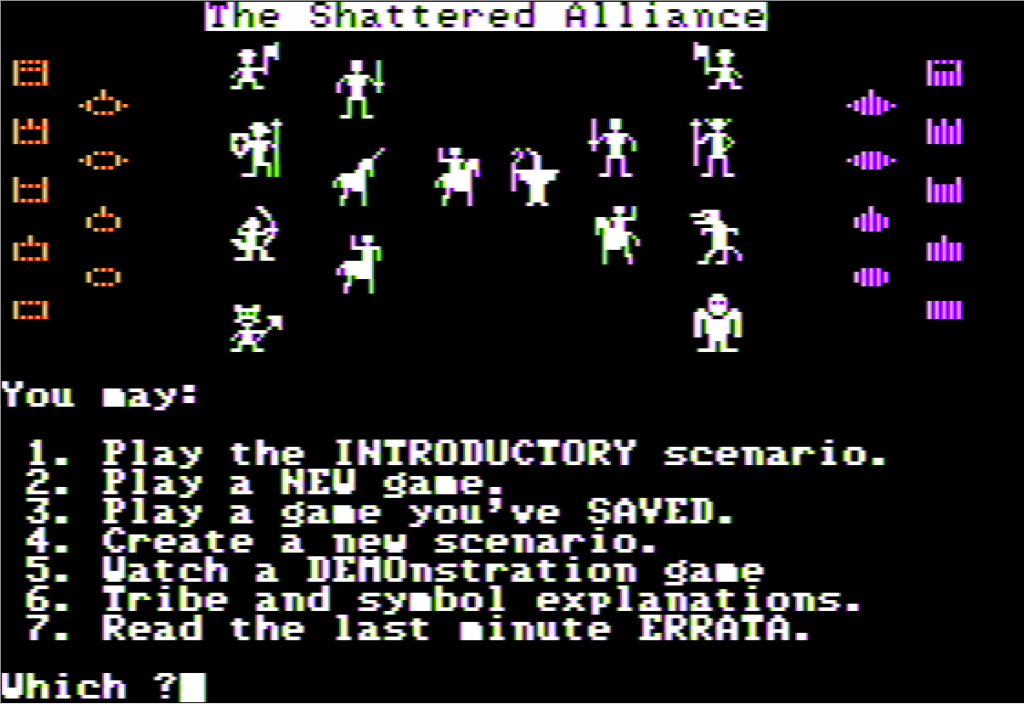
The Shattered Alliance by John Lyon, published by SSI, USA
First release : September 1981 on Apple II
Tested on : Apple II
Total Hours Tested : 5 – 6 hours
Average duration of a battle : 30 minutes
Difficulty: Average (2/5)
Would recommend to a modern player : No
Would recommend to a designer : Yes, but check Field of Glory II first.
Final Rating: Well-designed, but obsolete
In 1981, fantasy in computer games was starting to be all the rage. Advanced Dungeons & Dragons had started its piecemeal release process in 1977, bringing fantasy to three million tabletop players by 1981. Fantasy then transitioned from tabletop to computer with the seminal Ultima and Wizardry in respectively June and September 1981.
In this context, making a fantasy strategy game seemed like a good call for SSI : there was most definitely an audience, if the game could be tailored for that audience’s tastes.
John Lyon’s The Shattered Alliance was SSI’s first fantasy game, and, in true SSI fashion, it borrowed from an existing tabletop ruleset : the War Games Research Group ruleset. It had the advantage of being one of few tabletop rulesets with simultaneous turn resolution, and as such could easily be converted in what SSI wanted to do : a game simpler than earlier SSI titles which could be played in short sessions without waiting time. More specifically, the solution to waiting time was called “RapidFire” – a design according to which players did not have to wait for their opponents to play all their units, but rather both players would play their units in a mixed sequence, depending on how long a unit had taken to play its previous action.
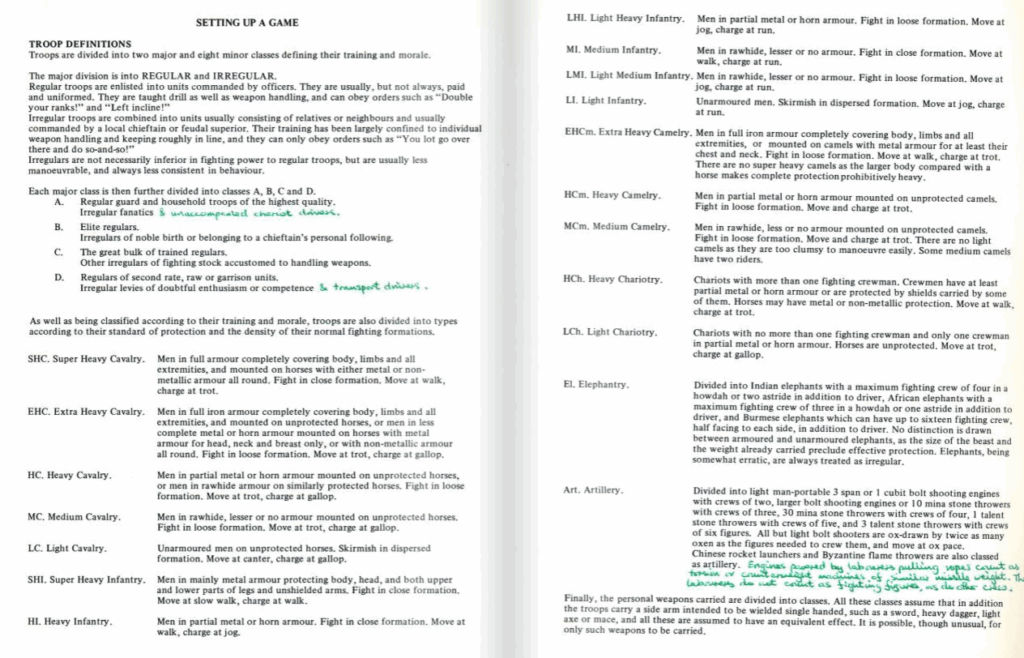
There was only one version of Shattered Alliance – this time the “magic” piece of code called RDOS that accelerated the 1.1 versions of Computer Bismarck, Operation Apocalypse and so many earlier SSI games came directly embedded in the game (as it had in Torpedo Fire already).
RDOS is a tiny OS with a very little memory footprint (an advantage in particular for those games coded in memory-onerous BASIC) that Roland Gustafsson had imagined on his own while not yet employed by SSI. According to an interview he gave to a French Apple II hobbyist, Gustafsson met Joel Billings in some interesting circumstances :
I worked on Saturdays at a Computerland store in Belmont, California. A friend of mine who was a regular customer there asked me if I could figure out how to copy SSI’s games so he could make me backups. I used one of the very basic backup programs (not a cracking program) that were available back then (this predates LockSmith, etc…) and it copied no problem. He was surprised that it was so easy and I said I could probably figure out a way to make it harder.
We immediately phoned up SSI on the store phone and he talked to Joel Billings (the founder of SSI) because they were friends and I spoke with him and set up a meeting. One Sunday afternoon my parents drove me down to SSI (I didn’t have my driver’s license yet) and I met with them and came up with a better system. Later, 1981, I wrote RDOS for them.
RDOS would be onboarded on most SSI Apple II games from that point onward, incidentally earning Roland Gustafsson an impressive credit list.
The Shattered Alliance was considered a premium game by SSI, sold at the higher $59.95 price point. The box included :
- A fairly large rule book, that also included historical background,
- Three reference cards,
- Two “commands cards”, in practice smaller cards which reminded the player about the keyboard controls,
The game also received an Atari port in 1982 (the first Atari port by SSI), which for some reason was sold at $39.95, and finally in 1984 a $15 “scenario tool kit” allowing the user to create maps and orders of battle.
A. Immersion
According to the manual, The Shattered Alliance recounts “the first battles of the planet of Osgorth“. The game was supposed to be the first of several Chronicles of Osgorth, the eponymous chronicles being supposedly found on a planet by a Terran expedition in “1169 P.H.” (Pax Humana). Their “archeological nature” is a neat trick that allowed the authors to jump from one event to another without being compelled to flesh out the universe too much.
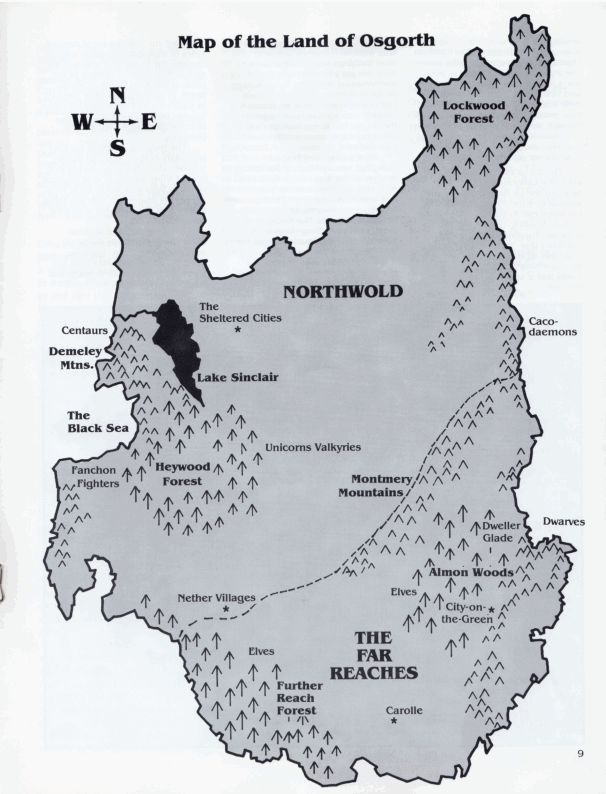
Stylistically, the writing is competent. The problem is that the world and story are extremely derivative :
- It starts with a description of the geography and population of the world, which can be summed up as “long ago, all nations lived together in harmony. Then everything changed when the
Fire NationOrcsZorgs attacked”. - After this introduction, the narration jumps to the shattered alliance itself : King Gavin is tricked by his advisor
WormtongueSorcerer Ormolu to attack his ally King Noran. The connection with the Zorgs storyline is tenuous at best, and from here on the narration becomes disjointed – I am not sure I understood everything the author wanted to convey. - After roughly 4 pages of these engrossing stories, you have 2 more pages describing the 17 races or factions of the universe, and then just to be sure, one more page of glossary.
But all this exposition is for naught : there are only four scenarios based on the Osgorth universe in the game. The end result is that I did not care about it at all, and to be clear I don’t believe the developer cared that much either – it really feels like he changed his mind mid-development.
Unfortunately, I do not care much about “Romans vs Vikings” types of battles either…
The Shattered Alliance has a fraught relationship with Lords of the Rings. The Elves and the Dwarves make it in the story, but not the Hobbits who become the “Hozgits“, nor the Orcs who become the “Zorgs“. But all those efforts not to use the O. and H. words are awkward when you can be the general of Gondor…
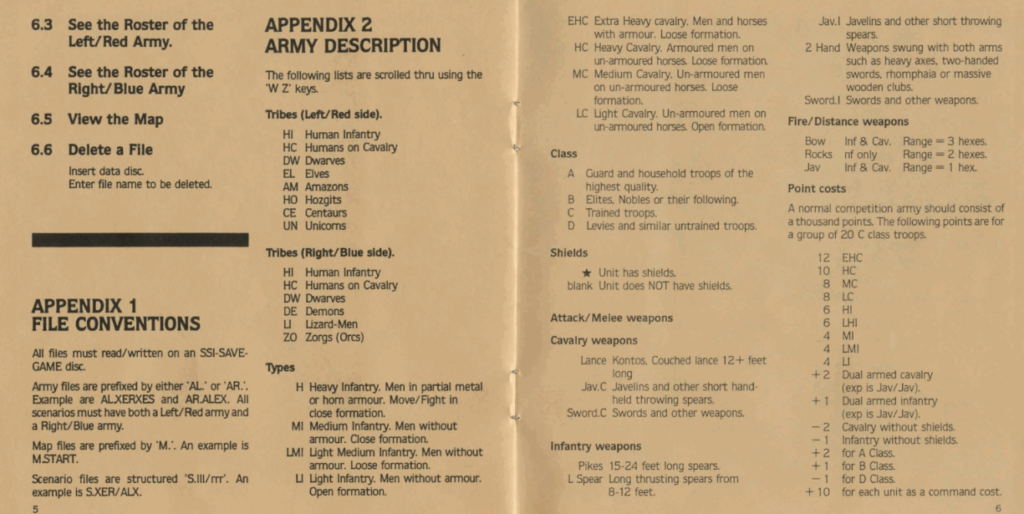
As for graphics, they are good compared to any earlier SSI game, but obviously they did not age well.
Rating : Very poor
B. Systems
In addition to RapidFire, the game has some distinctive features I have never seen elsewhere, except in Field of Glory II. To focus on these features exclusively :
Unit stats and combat
Unlike many other games, units are not defined by intrinsic values (eg X attack strength, or Y defense). Instead, they are fully defined by the intersection of their class (from Light Infantry to Extra Heavy Cavalry), their quality (from A to D) and their equipment (7 type of weapons).
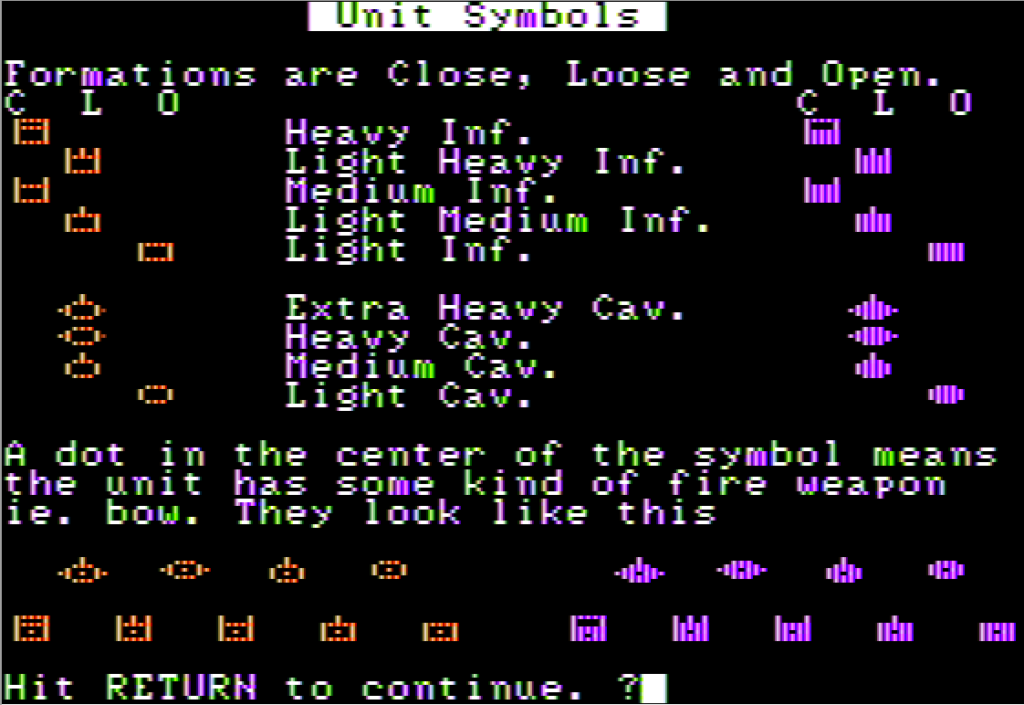
To resolve a melee combat, the game first calculates a “melee factor”, which is the addition of a weapon factor + a tactical factor + a random factor.
- Weapon factor [WF] is the intersection of the attacker’s equipment and class of the opponent :
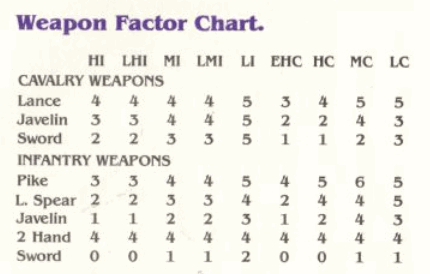
- The second value is the tactical factor [TF]:
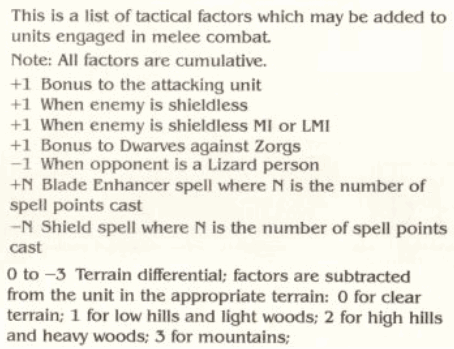
The only modifier that needs commenting is magic : units can have a number of magic points in reserve, that never ever recover. Those magic points can be used to increase a unit’s factor in attack (Blade Enhancer spell), decrease the enemy factor in defense (Shield spell), but also increase morale (Courage spell) or, if you want to waste your magic, move very marginally faster (Haste spell).
- The third value is the random factor [RF], which is the difference (positive or negative) between two random rolls going from 2 to 5. It is the only moment in combat when unit quality has some (limited) impact :
- units of quality A and B can never have a RF below -1,
- units of quality D can never have a RF above 1.
Taking as an example this battle from the AAR, where my dwarves got slaughtered :
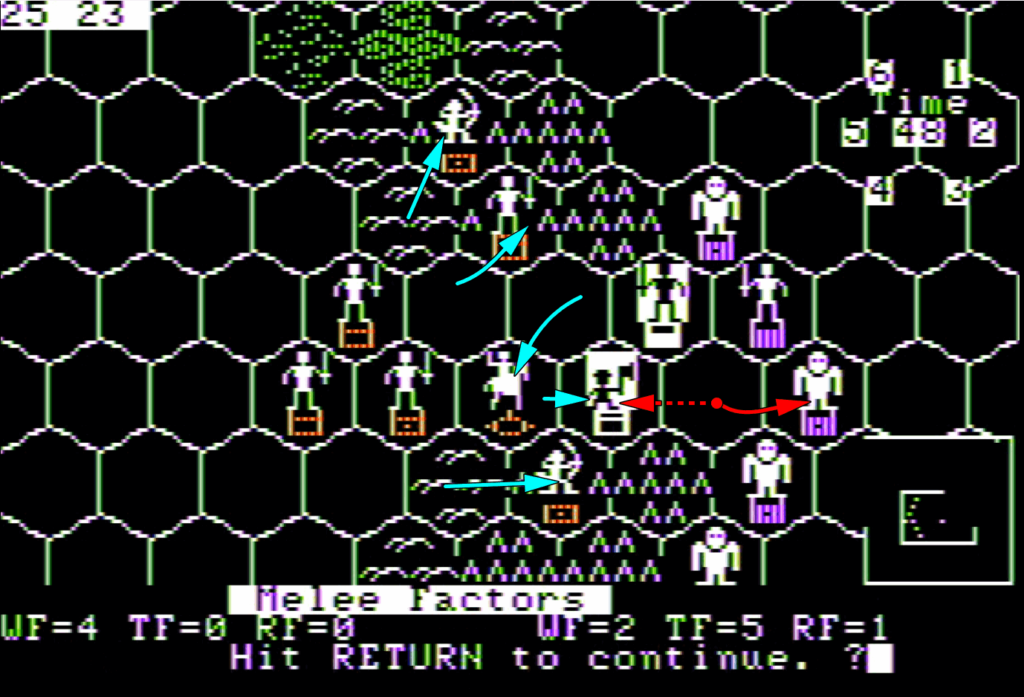
- Weapon Factor (WF): My dwarves had 2-hand weapons, so regardless of who they faced, their WF was going to be 4. The humans facing them had swords. The dwarves are heavy infantry [HI] so the humans have WF = 2.
- Tactical Factor (TF): The humans have shields, and the dwarves don’t because well they have two-handed weapons, so +1 for Mordor. In addition to this, Mordor was attacking (+1) with max Blade Enhancer spell (+3) for a total TF for Mordor of +5.
- Random Factor (RF): Mordor got lucky at +1.
Those results give a total of 4 melee factors for Gondor, and 8 for Mordor.
This result is then compared to a casualty table which represents how many casualties the defenders (attackers) received as a percentage of the number of attackers (defenders) – in our example, respectively 25% and 10%.


In my example, Mordor lost 10% of 420, so 42 soldiers, while the dwarves lost 25% of 467, so 112 dwarves.
Ranged combat is the same, except that the weapon factor is either 0 or 1, random factor goes from -1 to +1 and the tactical factors are usually smaller too. Range goes from 1 (javelin) to 3 (bow).
Morale
In Shattered Alliance, units usually don’t fight until their complete destruction, and battles don’t last until all units are destroyed. Rather, units fight until they rout, and battles last until the morale of one of the armies collapses.
An army can rout in two circumstances :
- The most common : a unit routs automatically if it has lost a certain number of consecutive melees without moving, depending on the unit’s quality : from 4 consecutive defeats for quality A units … to only one defeat for quality D units. Losing a melee means losing significantly more folks than the other side in combat.
- In addition to this automatic rout, there is a morale test the first time a unit attacks another in melee after a movement, or if another unit is routed within 3 hexagons. This test of morale is done by rolling 3 times those 2-5 dice, adding some modifiers :
- -1 for each 10% of the unit dead since the beginning of the battle,
- +1/-1 for each melee battle won/lost,
- +1/-1 for each non-routed allied/enemy unit within 3 tiles,
- +1/-1 for each enemy/allied unit routed anywhere,
The result is compared to a threshold :

Routing units move away from the closest enemy every turn. They don’t defend themselves if attacked, and cannot rally (which is a regular morale test) if they are within 3 tiles of an enemy.
Army morale is only used to determine a winner. It starts at 24 in most cases, and goes up and down depending on melee battles won/lost, routs or destructions. If army morale ever reaches zero, the other side wins.
How well does it all work ?
Overall, it works well. As I said, Shattered Alliance works a bit like a simplified fantasy Field of Glory II with a maximum of only 8 units available for each side. Quality of equipment is important, and a well-equipped unit can inflict devastating losses. At the same time, very large units, even with poor equipment, can absorb very large losses and often win melees because even though they caused only 4% of their number in damage, that’s 4% of a number so large it outweighs the 8% of the other side.
The morale system also creates a realistic domino effect. The minimum roll of the 3 dice is 6 and the average roll 10.5, so initially most units are safe. But by the middle of the game, many units are depleted, so -3 or worse modifiers are not uncommon. Every rout typically puts you at -2 (one for the rout, one for being outnumbered) so after one rout you can get unlucky with your B and C units, and after 2 routs your B and C units will flee sooner or later if you test them. A large part of the game is understanding when a unit is on the brink of collapse and should be pulled back.
The system has some huge weaknesses in my opinion though :
- There is no bonus for attacking an enemy from multiple sides, though of course this spreads the losses you receive as an attacker and is more likely to trigger early on one of those all important routs,
- It is extremely dangerous to split one’s forces, as this will create a massive negative morale effect (due to the outnumbered within 3 tiles morale modifier).
Together, those two weaknesses entice the player to remain very grouped – there is no flanking movement, decoy attack or other tacticool moves – especially since you have only 8 units maximum.
Another problem I have with the game is the peculiar choice of letting archers shoot then move in the same activation. In more open battlefields, and especially against armies without cavalry, it makes the game both long and easy to win : just stay far away and shoot.
Rating : Good.
C. UI , Clarity of rules and outcomes
If we ignore the 5-page erratum, the rules are surprisingly clear. They are also easy to understand because the game gives you an interesting option : you can choose whether you want the battle report and the morale check to be verbose or quick (I used verbose in my AAR).
The two levels of zoom is appreciated, and the strategic map is really well-done (when not in AAR, I directly play on it), the transition between the two is anything but smooth though.
There are a few issues though: you have limited time to play your turns, though thankfully you can set that at 60 seconds. And because the game is supposed to be played fast it is impossible to check the situation (morale, losses, …) of any non-active units – same problem as Tigers in the Snow and quite a few other games.
Rating : Good
D. Scenario design & Balancing
Let’s start with the AI : as with earlier John Lyon games (Computer Napoleonics, Torpedo Fire), the AI is terrible. In my AAR, Mordor’s cavalry never supported the infantry, and thanks to this I won easily despite several blunders.
Scenario-wise, in addition to the tutorial scenario (a 3v3), the game offers 8 scenarios : 4 Osgorth, 4 non-Osgorth. Of these :
- 1 is an ambush scenario,
- 1 is a special scenario where the player must kill Ormolu, a unit of size 1, the “difficulty” being that there are 4 “mirror” units on the map that look exactly like Ormulu but cannot be attacked when you reach them. The scenario is trivially easy because Ormulu only casts a few weak spells from time to time, and can be easily swatted like a fly when you reach him :
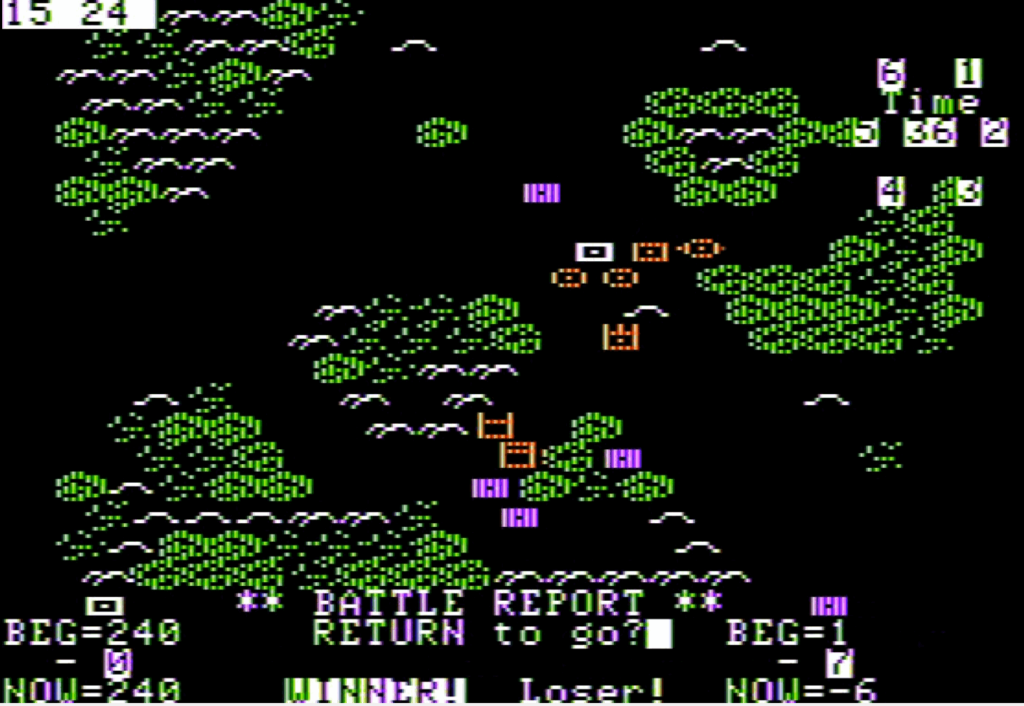
- 1 is the Gondor vs Mordor scenario,
- All other 5 scenarios are more traditional line battles, either fantasy or “fake ancient”, with some differences in the line-up, but in practice, since the AI does not know how to use its units, they all play mostly the same (except Xerxès vs Genghis Khan, because Mongols).
Battles are overall not very well balanced. You can give some advantages to the AI, but these are not granular enough :

Seven available battles may have been plenty for multiplayer, but in single-player mode, fast battles and AI weakness means I burned through the content quickly.
The Shattered Alliance includes a “scenario editor”, but it must have been very frustrating back then : you can only pick one army from the list of armies for the left player, and face one army from the list of armies for the right player.
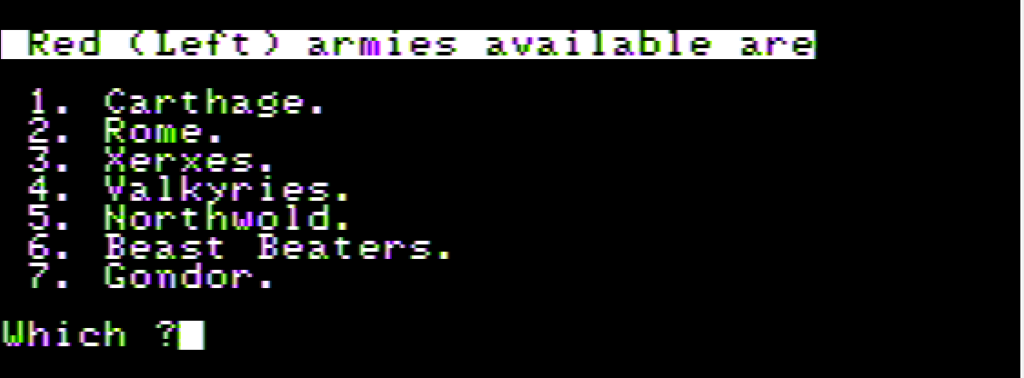
This was only solved with the 1984 data disk, which allowed the player to edit armies or battlefields freely (as long as you had a maximum of 8 units by side), though I did not test it.
Rating : Very poor
E. Did I make interesting decisions ?
Yes, a bit.
Some scenarios were all about kiting the enemy with arrows, but other scenarios were real tactical challenges. Due to the battles being so short, a battle is all about a few decisions at the beginning (wait for the enemy or attack, which enemy unit to focus on) and then knowing when it is time to rotate a depleted unit away from the frontline – this is pleasant.
But the lack of diversity in viable options quickly reduces the interest of those decisions – after a few battles you don’t feel you are making thoughtful decisions, instead you follow logical courses of action.
F. Final rating
Rating : 40 years later it is well designed, but obsolete.
The Shattered Alliance was without any doubt a very well-designed game in 1981, but in single player it is in large part ruined by the terrible AI and by how little we care about those battles – there is no campaign mode and the battles proposed failed to engage my interest. I hesitated a bit to rate this game “still interesting”, but there is nothing this game does that Field of Glory II doesn’t do way better.
Contemporary Reviews
The Shattered Alliance gathered almost immediately a lot of reviews (for instance Softalk as soon as September 1981) but initially those remained uncommitted. The trend broke in February 1982 with two reviews :
- One from Computer Gaming World (issue 2.1) : reviewer Bob Boyd praises the game graphics and how fast to play it is, and concludes by saying the game is very satisfying. This review was later confirmed by CGW’s readership : they ranked it second (after RobotWar) in the June 1981 issue.
- Another from the Space Gamer (issue 48) : reviewer David Bolduc praises the morale system (“it adds a new dimension to gaming“) and while he states the game has various issues, he recommends the game heartily :” it’s loads of fun to play, semi-addictive and fast. […]. It represents a significant advance in computer gaming and is well worth the investment.” Bolduc commented that the AI makes a “fair opponent” though a predictable one, but his final comment on the topic (“I’ll bet it beats you the first couple of times you play it“) does not sound like much of a praise.
The Book of Atari Software dissents, and the 1983 edition gave the game decidedly average ratings. While I think that most of its criticisms are unfounded (“there is a consistent emphasis on [Tolkien]-type characters , name and combat situations which Bilbo and Frodo fans will find both unsatisfactory and insulting” – come on !) it is the only review to flag the issue that adjacent forces provide neither offensive nor defensive support. The review also states that it is inferior to Operation Apocalypse – I disagree.
The game was extremely well received in France, having the honor of being the first video game reviewed by the burgeoning magazine Casus Belli. François Marcela-Froideval calls the game “superb“, only complaining about the battles ending too soon : “If you need to own only one computer game, it is this one”. The game was also part of the Jeux & Stratégie 1984 list of “the 33 best computer games” (they call it “a very great game” – amusingly they focus a lot more on the semi-historical forces rather than the fantasy ones, barely mentioned as a side note).
In France, only Tilt is more lukewarm in its 1984 review of existing wargames : they rate it 4 stars out of 6 but still it is “a very good game if you don’t want to think too much”. Funnily enough, Tilt praised the Shattered Alliance for being “close to historical reality” in its recreation of ancient history battles like the one between Carthage and Alexander the Great.